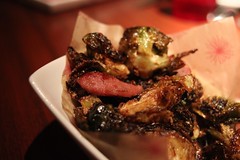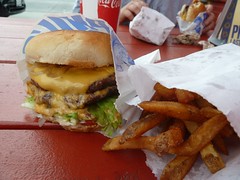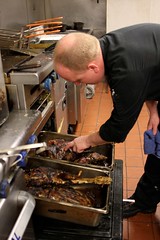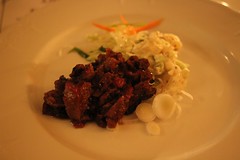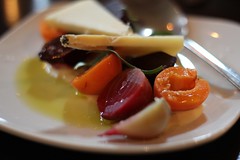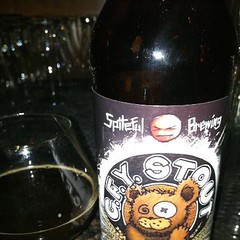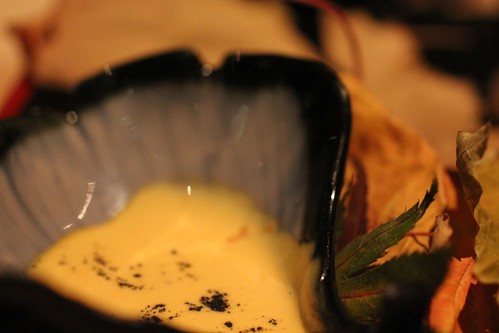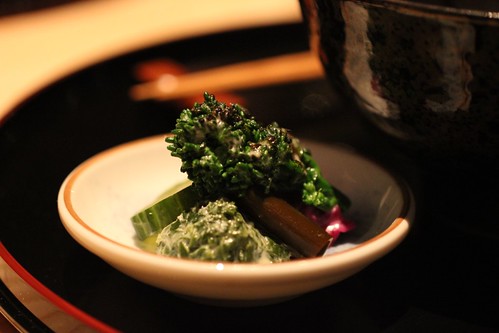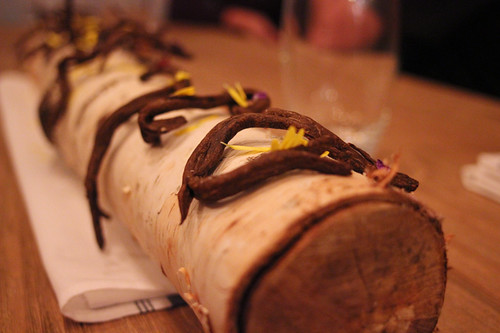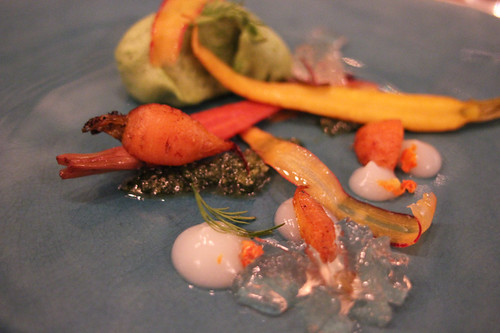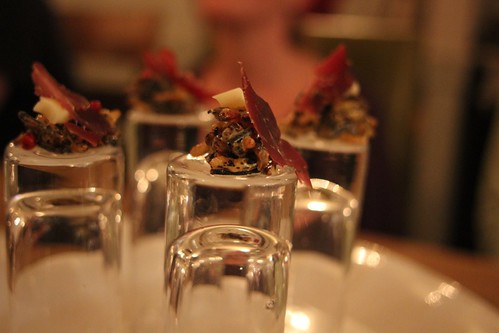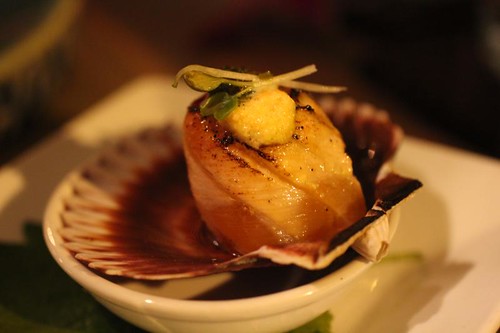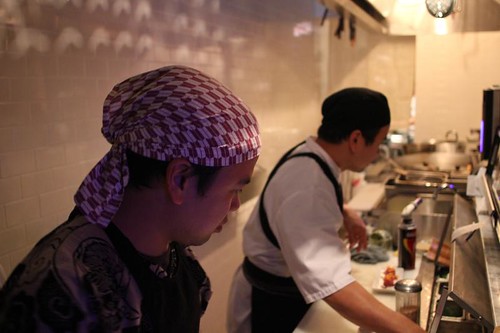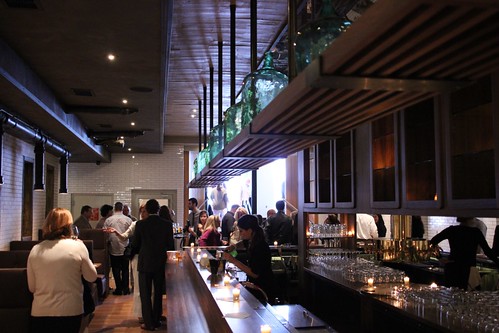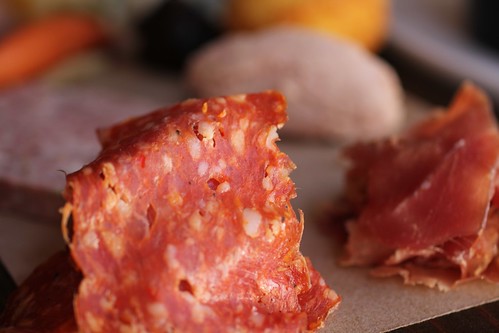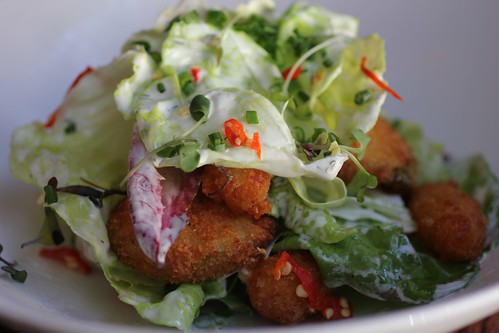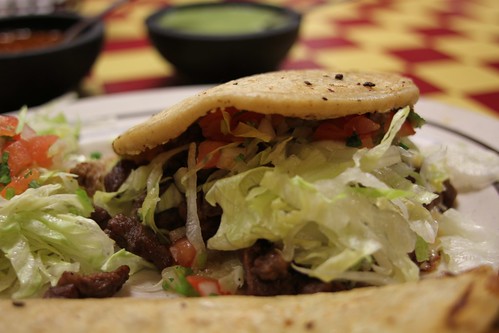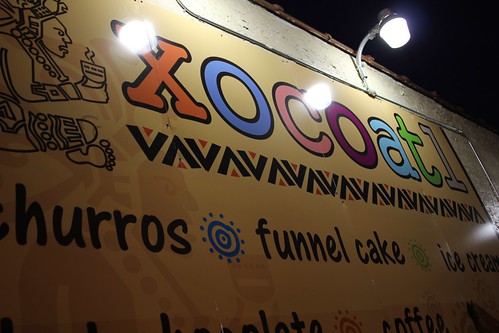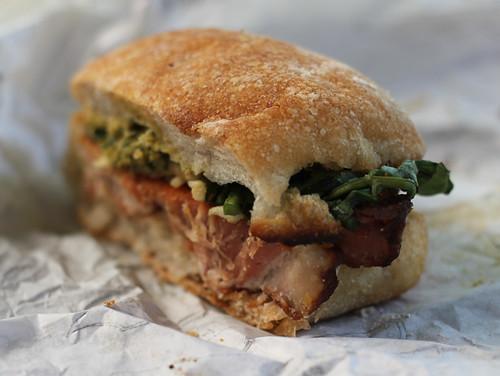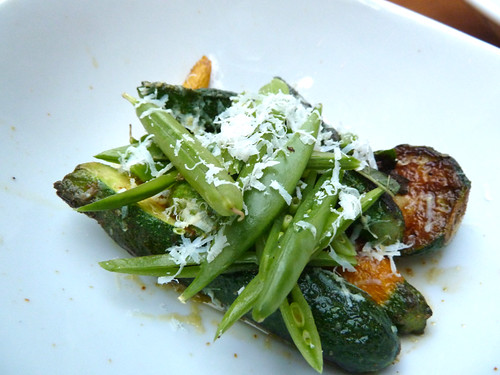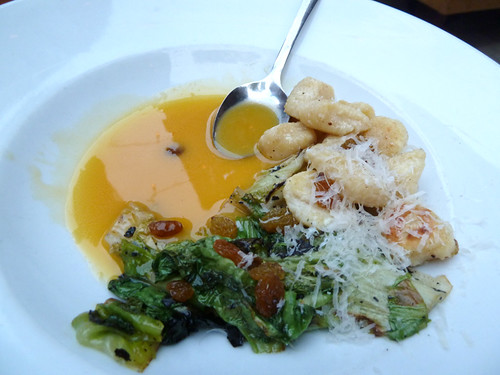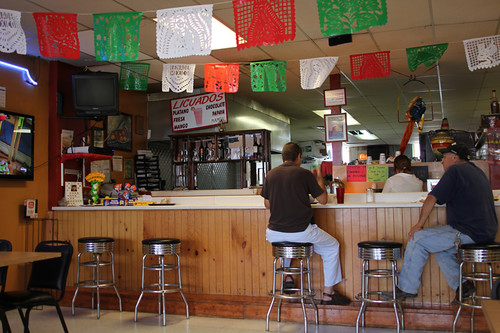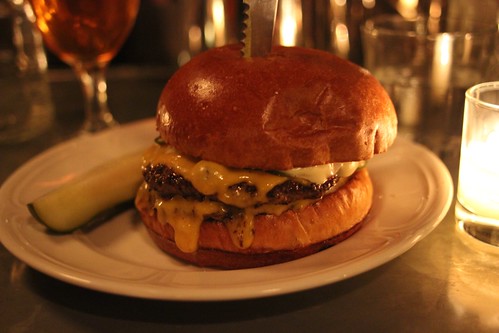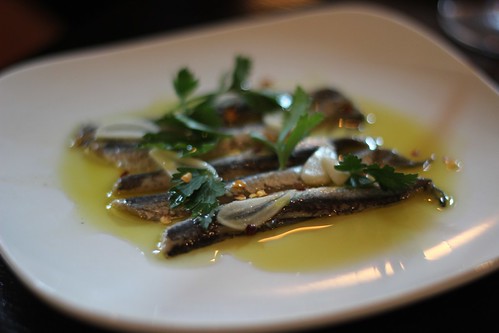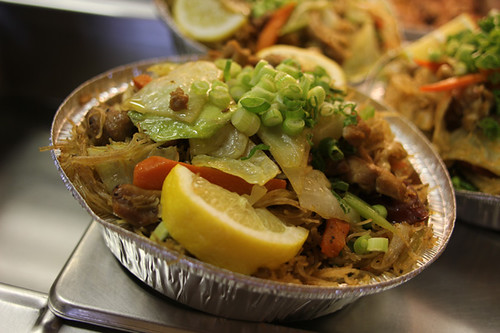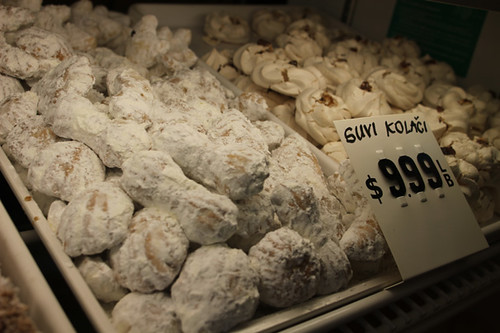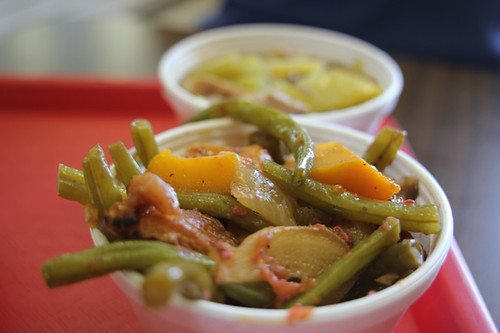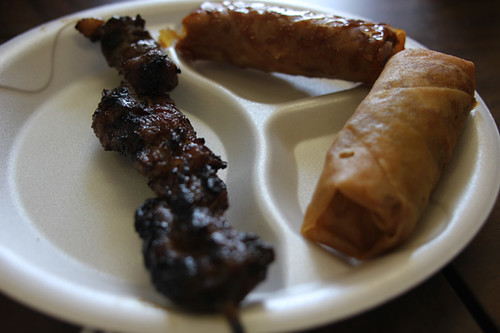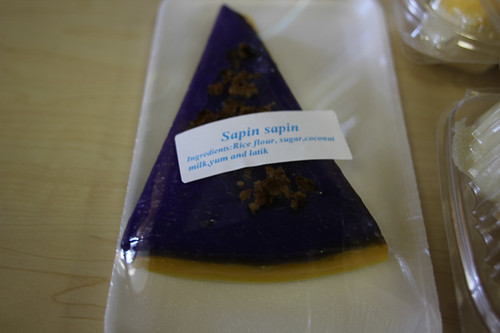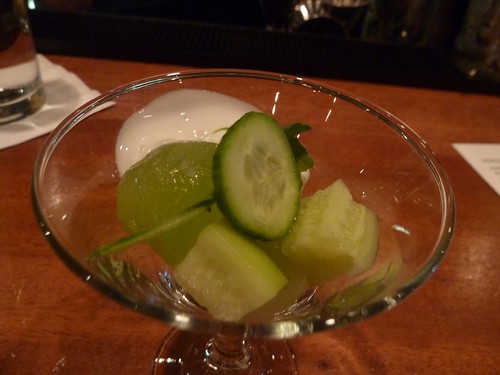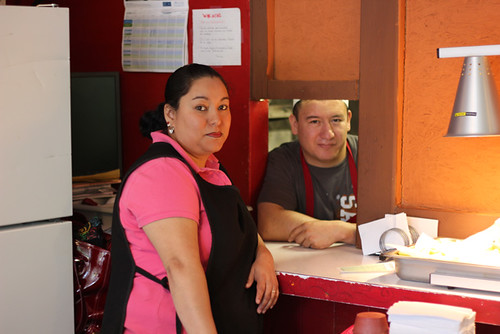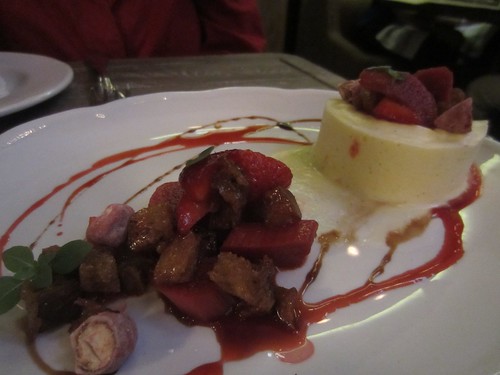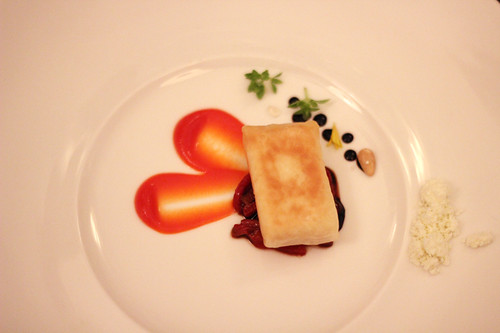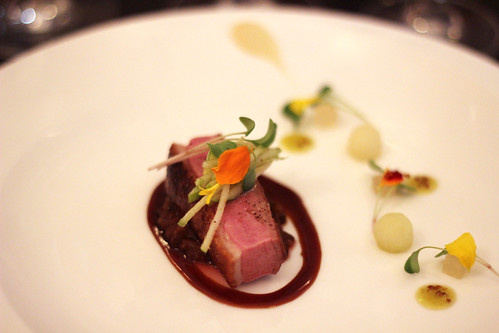
Totto Ramen in New York.
For a long time I didn’t get why ramen was such an object of hype and obsession among foodies. It’s not that I associated it with the 50-cent packet kind— I’m not sure I’ve ever even had that. But to me it was soup, so it had noodles, and broth— and so do a lot of other things. Yet only ramen attracted the kind of mania that not only searches for perfection but, unfortunately, often uses food as a cudgel to lord it over someone else with—

“Think you know ramen, my droogies? You’ve never had the real horrorshow ramen from Vancouver, ya great stinking globs!”
But authentically-made ramen took off here last year and this year the way Neapolitan pizza did a few years ago, and ramen keeps forcing itself on me. And I guess I get why it’s such good material for obsession now— it’s super-simple, but each of its components can be debated to the end of time— is the broth porky enough? The noodles chewy enough, or not too chewy, or springy or wheaty or whatever you think the key attribute of noodles ought to be?
In New York I went to Totto Ramen, and its toothy noodles and deep, porky-funky broth seemed to establish themselves for me as at least one lodestar for what ramen ought to be— maybe you prize different virtues, but it gave me something to compare the others to. Next I had The Aviary’s ramen at an event I attended, and… well to be honest I’d tried too many Aviary cocktails by that point to be in full reviewer mode, but it seemed in the same ballpark. So from there, I was off and ramen, trying it wherever I could…

Can you believe I had never been to Ginza for sushi? (Oops, I still haven’t, actually.) I used to work in that area but frankly, sushi restaurant in skid row hotel scared the hell out of me in the 90s, before I was a Chowhound and fearless. I popped in there after a Key Ingredient shoot or something downtown and found it exactly the place I should have been going to all along, a 60s restaurant in Japanese Danish modern conjuring up a whole lost world of salarymen trying to push cheap Made in Japan gear at the Merchandise Mart, where the sushi chefs expertly prepare your fish while ignoring your gaijin ass and talking baseball in Japanese (you could recognize the occasional player name). The ramen wasn’t deep or profound, but it was like good diner food in its comforting reliableness. I’m going to have to go back for sushi now.

Back in the dotcom era, when I worked in the converted warehouses of River North, Cocoro Restaurant seemed a very sleek and chic modern Asian spot for lunch, specializing in shabu-shabu (hot pots in which you cook thinly sliced meat and vegetables yourself). Returning to it after a decade, it seemed much more homey and down-to-earth. So is that the inevitable fate of even today’s glitziest Asian spots? Will Japonais or Jellyfish someday seem as corner-diner easygoing as this place does now? Well, only if they get someone as warmly welcoming as owner Yuko here, who came by my table dispensing a warm smile every time; funny that I had not picked up on the place’s real attraction long ago. Anyway, ramen is good if not as deeply funky as the very best; pillow-soft tofu in a well-rounded udon was better.

All those ramenheads and their droogies have praised Santouka, the only Chicago outlet of a Japanese chain also on the west coast, located in the Mitsuwa Japanese shopping mall in Arlington Heights. I expected it to be the bee’s ne plus ultra, but I found the broth less rich than many of the above— which forced me to reconsider whether that was another model of ramen I should be respecting, and the deepest of the others had been too heavy-handed. Or maybe it’s just mall food court Japanese and I shouldn’t expect so much of it.

Whatever, this ramen has an ace in the hole that none of the others so far had. For a $3 upcharge they’d put slices of pork cheek in it. A lot of slices of pork cheek. Which was as soft and supple as something really soft and supple. This was one sensual bowl of ramen.
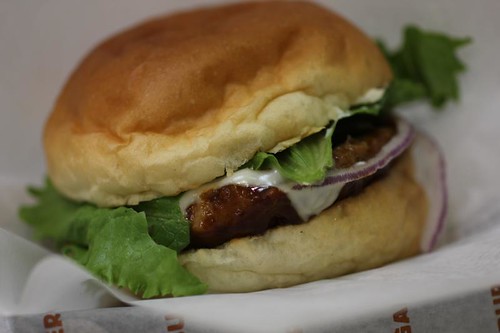
While there I wanted to try something else that’s comparatively (ie last year or two) new to Mitsuwa— Gabutto Burger. It’s a Chicago guy who set out to make, I guess, a Japanese burger. And it is, to be honest, something of a lesson in how you may, or may not, get what’s going on in some other culture’s classic dishes… like, say, ramen. There’s mayonnaise, not surprisingly in a Japanese dish, and also a kind of beef jus that is like what you’d get in a pot of braised beef or pot roast or something. Add that the patty is all kind of one texture, and to me this just misses what burgers are about to Americans— that unique contrast of crispy seared beef with the sweet and sour of ketchup and mustard.
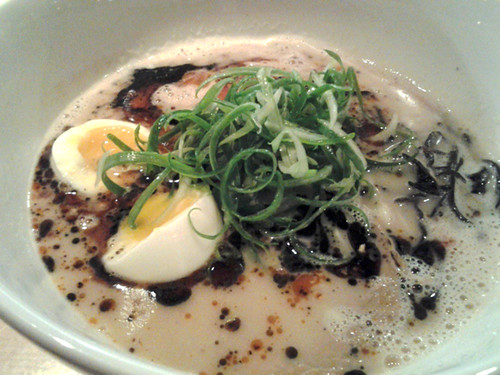
Oiistar is a hip new place in Wicker Park, the inside is done in blocks of raw wood (uncomfortably, in the case of the one you sit on) like a Bill Kim belly joint, and unconventionally in terms of what the ramen is like. Which is to say, there isn’t a normal bowl of ramen to be had here— the simplest one (the Oiimen) is still dressed up with fried garlic and chili oil, and that’s before you get to things like the Pozolmen with its jalapeño and tomato. Spice is often used to cover up inferior quality, but I managed to dredge up an un-chili oiled spoonful with the comically large spoon they give you, and it seemed a thoroughly respectable broth with good porky flavor; the noodles, thin and as curly as a phone cord, were good enough but I like a little thicker and chewier noodle. Entirely decent in an Americanized-concepted way— though for what it’s worth, at $14 it was also surely the most expensive as well. Even without strips of pork cheek. Oii vey!
* * *
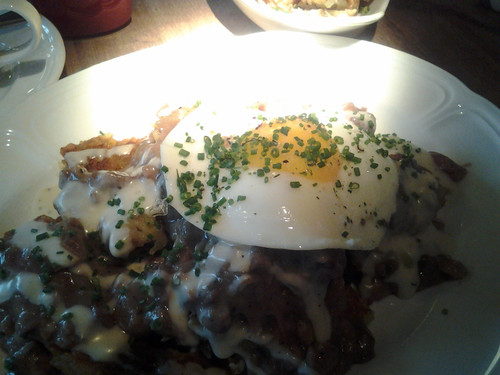
This looks like a bad flash picture, but actually the dish was sitting right under the spotlight that shines brightly on the middle of your table at Au Cheval, apparently in case you have to suddenly perform open heart surgery on a hamster during your meal.
I remain, to judge by its regular appearances in my Twitter feed, the only person who doesn’t love the Au Cheval burger. I’ve meant to go back to give other things a try and see if I liked the restaurant as much as, say, Michael Nagrant, who found the duck heart gravy hash one of the greatest things ever… but it can be a little harder to motivate yourself for an experiment confirmation rather than a meal. I wound up there one Sunday morning when I drove by Little Goat Diner, saw no big line waiting, went and paid a bunch of money to park, walked over to it with my son… and was promptly told there was an hour and a half wait. How could the six people in the entry way add up to that? Then I remembered a vague mention of buzzers. The other 60 people in front of me must be on the Little Goat Bread side, sipping coffee and waiting for their buzzer to go off.
With so much money sunk into parking, I tried to find somewhere else to go in the area— and what did you know but we were 2 minutes from Au Cheval opening for brunch. Unlike last time, when they seemed vaguely baffled by my presence as a customer, they were friendly as could be, albeit, there was still a slight sense that they believed that they were not so much servers as people who were playing servers on TV, or possibly in a department store window. In sunlight, the dark bar was still dark and hardly diner-y, but it was at least possible to see one end from the other. It was quiet enough, at least at first, that I could actually hear the music playing from the reel to reel tape player in the front. Was there an audio difference? It did seem quite clear and rounded, natural in its tones….
I took Nagrant’s advice and ordered the thing I had planned to eat the next time I went there, the duck heart hash, luckily on the breakfast menu. Which is to say, I ordered mounds of potatoes, a peppery gravy studded with braised duck heart, and egg, while my son had their aptly-named Simple Breakfast. Again, excess was the order of the day— his eggs were Scrambled Butter— but this time I could see expertise and skill and something of a guiding hand making composed dishes, not merely piling it on. The sweet, thick-cut bacon was terrific, the gravy was deep with flavor; the hash was fried perfectly into too-neat perfect squares, the egg was exactly at the runny point it should be. On its own terms, nailed.
Yet I have to say that I still can’t fully buy into Au Cheval’s indulgent, eat-like-a-teenager ethos (which is also, at least partly, that of sister restaurant Maude’s Liquor Bar as well). I loved a vegetable I had at Maude’s (brussel sprouts), yet the idea behind all of this food seems to be to allow you to gorge on the fun stuff with no balancing from any other food group— and ultimately that’s a lifestyle too one-dimensional for me, at least very often. There’s some of that relive-your-childhood-way-of-eating at another popular new restaurant, The Trenchermen, what with pickled tater tots and so on, but somehow it always takes a turn there that acknowledges you can’t go home again and you are an adult who expects tastes of adult complexity. There’s nothing complex about Au Cheval; it plays all its cards up front. The first bite tastes indulgently, belly-rubbingly pleasurable, and thirty bites later, you’re still eating the exact same thing and experiencing the exact same feelings from it, a lot fuller.
* * *
The short life of an Andersonville restaurant called Premise, which took place within a few months of 2012, prompted media question-raising about whether modernist or exotically nose-to-tailish food could ever make it in the neighborhoods rather than downtown (even though, presumably, it’s pretty much the same people eating it in both places). What no one seemed to notice was that Storefront Company, which opened around the same time, was buzzing along fairly successfully doing just those things in Wicker Park without much hype or angst.
I went there early on and found it a little more squiggles than substance, like a hotel restaurant’s version of trendy food, but with some strong points (a very good cheese program for a neighborhood spot, a terrific savory-sweet dessert based around parsnips which could have come from Schwa). But by around the one-year mark chef Bryan Moscatello seems to have grown into his own comfort level with modernist food, making use of everything in a matter-of-fact way so that it doesn’t scare off the locals when a slice of pickled rabbit heart decorates a neat plate of geometric bits of food, in all its biology-textbook detail. Nothing is too out there, which maybe means it never quite scales the highest heights either, but for a relatively affordable, comfortably chic spot alongside pizza parlors and nail salons, it demonstrates a lot of confidence with the direct flavors of house-butchered whole animals. (Vegetables seem rather an afterthought— but dessert is not.)
Disclosure: Storefront Company was a media dinner; the Aviary ramen was part of an event I attended as a media guest; everything else was eaten like a normal person.


 Posted in
Posted in 

